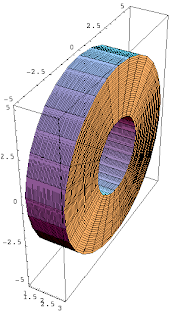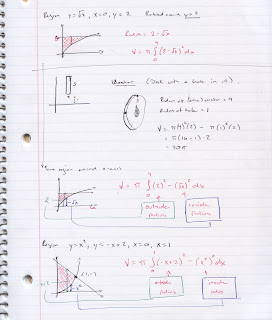The geometry problem that relates here is this - given that there are two concentric circles, one with a radius of 5 and the other with a radius of 2, find the area of the purple region in between them.

The calculation to find that purple area isn't particularly difficult:
π(5)^2 - π(2)^2 = 25π - 4π = 21π
Most calculus students feel comfortable with this idea. Recognize though that we never worried about the fact that the "radius" of that purple area is 3 - it never comes into play.
When you rotate a rectangle around one of it's edges, you get a disk (cylinder). When you rotate a rectangle around a line that is not an edge, you get a solid that we will call a washer. Note that it is a cylinder with a smaller cylinder removed from the center.
If we take a rectangle with opposite vertices (1, 2) and (2, 5) and rotate it around the x-axis we get the following washer.


Recognize the geometry problem with the purple and gold circles. Finding the volume of the washer is the same idea. We'll use the formula:
V = π(R^2)H - π(r^2)H which simplifies to π(R^2 - r^2)H
So in this case, the volume of the washer is V = π(5^2)(1) - π(2^2)(1) b= 25π - 4π = 21π.
To find volume when we rotate regions around horizontal lines, we'll use
V = π Integral( (R^2 - r^2) dx) where the dx represents the (infinitesimal) height of each washer.
Notes from class today are below.

No comments:
Post a Comment